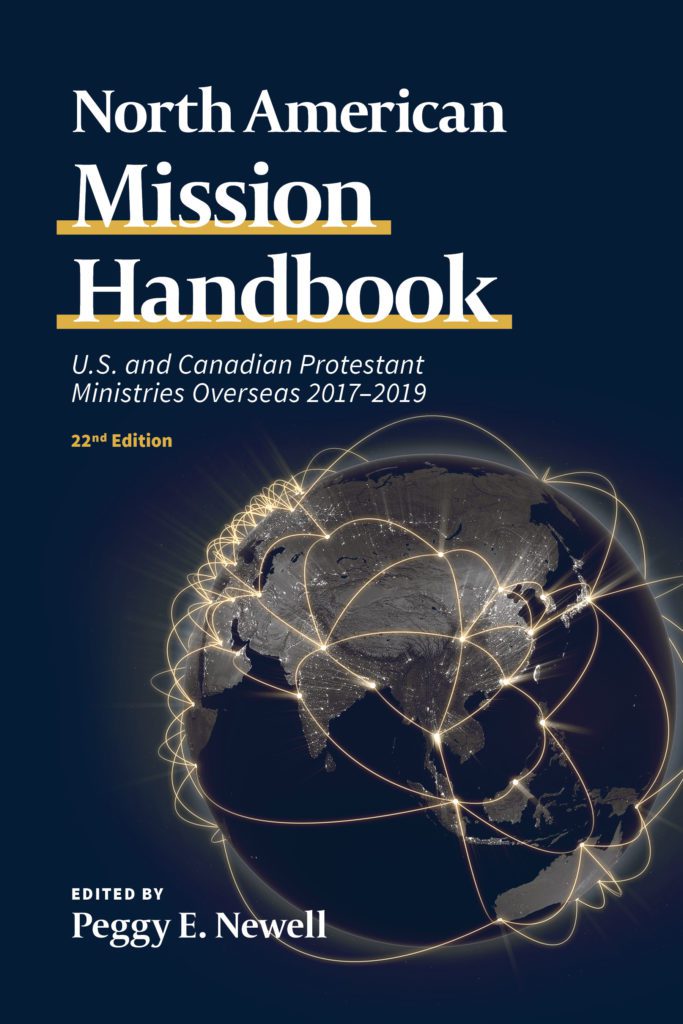North American Mission Handbook: US and Canadian Protestant Ministries Overseas 2017-2019

Missio Nexus’ leadership thoughtfully summarize books, giving you the Leader’s Edge to help inform, stimulate and provoke profitable discussion.
Leader’s Edge (Missions/Ministry)
North American Mission Handbook: US and Canadian Protestant Ministries Overseas (2017-2019)
Peggy E Newell, Editor
Publisher: William Carey Library, 2017, 683 pages
ISBN: 978-0-87808-632-0
Summary
The Mission Handbook has been in continuous publication every three years since 1953. It is a reference source to help new inquirers discover what agency fits their passions, interests, and gifting. It is one of the best places to look when someone is considering joining an agency. The book’s newly researched information and data guides the inquisitive person to a country of interest or specific ministry calling. Professors and researchers use the data to understand the state of North American missions, viewing trends in financial giving, resources, and personnel serving in short-term, mid-term, and long-term missions. Mission leaders, both here and abroad, use the book as a source for discovering peers and potential mission partners in various ministries and/or countries around the world, as well as strategizing what areas of the world are without adequate witness.
Table of Contents
Foreword
Introduction
Chapter 1: Our Global Families
Chapter 2: Mission CEO Survey Summary
Chapter 3: Mission Pastor Survey Summary
Chapter 4: Mission Handbook Survey: Perspective and Dynamics
Chapter 5: Directory of North American Agencies
Chapter 6: Countries of Activity
Chapter 7: Agencies by Ministry Activity or Church Tradition
Appendices
Best Illustration
“The value of supporting staff for the effectiveness of field workers is incalculable. Before sailing to India, William Carey said to the small band of brothers around him, ‘Well, I will go down into the mine, if you will hold the rope.’ This office staff category includes mobilizers, trainers, coaches, administrators, finance people, and a host of others that make the ministry of field workers possible.” Page 54
Best Idea
“Let us not lose sight of the global church that is rising up in a new era of training and sending out of workers to the harvest. As North Americans let’s do all we can to stand alongside our sisters and brothers from around the globe, to learn together, serve together, and through our unity in Christ see our mutual goal reached–the gospel taken to every tongue and tribe, till all have heard before Christ returns.” Page 93
Best Take Away
“However, the data contained here should give one pause before writing an obituary on the North American mission movement. There is a growing vibrancy in missionary organizations, churches and educational institutions as they grapple with the challenges of our day, as they strive to partner well, as they attempt to understand the task and stay focused.” Page ix
Our Recommendation
The recommendation of this book comes from one of the book’s endorsers, Scott W. Sunquist Dean, School of Intercultural Studies, Professor of World Christianity, Fuller Theological Seminary, “To have such a rich diversity of information about missions, the global church and the current needs in mission in one place is a great gift for the church. I pray that schools preparing missionaries, missions executives and church leaders will read and study these pages together. Then the value of this gift will be realized.” Page iv
Best Quotes
“Four (Global) trends for the 115-year period (1900-2015) are immediately apparent: (1) Christians’ percentage of the world’s population declined slightly; (2) Muslims have experienced the most significant change in proportion for any of the large religions; (3) Buddhists’ and Chinese folk-religionists’ combined share of the global population shrank by over half in that period; (4) agnostics and atheists experienced the largest percentage growth, from less than 1% of the world’s population to well over 11 percent.” Page 14
“CEOs were asked to identify their Top Picked Personal Priorities. The largest percentage emphasized a need for continued attention given to Spiritual Discipline as a guide for their leadership responsibilities. This is followed by an ability to provide Servant Leadership to their organizations. Servant Leadership and Spiritual Discipline lead the top priorities as they did in the 2013 study. These are followed by the ongoing need for continued Leadership Training and time given to Fundraising.” Page 19
“The 2016 study identified that Organizational Agility and Adaptability was a high-level priority for staff effectiveness. With many millennials now working in mission offices, an increased desire for flexible hours, workspace, location and less hierarchical processes has brought an increased need for adaptability from more traditional office structures to allow for more flexible working conditions.” Page 20
“Sixty-one percent of CEOs reported that Organizational Revenue compared to three years ago had increased, twenty-three percent reported that it had stayed at the same level and fourteen percent expressed a decrease in revenue. Overall this is very encouraging news regarding the increase in revenue coming in to North American mission organizations over the last three years. Similarly, positive news was recorded for the Number of Field Personnel actively serving. Fifty-seven percent of CEOs reported that there was an increase in field personnel over the last three years. Twenty-six percent showed the number remaining the same and sixteen percent reported a decline in field personnel.” Page 21
“Eighty-one percent of CEOs felt that understanding how their workers are doing spiritually is one of the most important markers for progress. When asked in a separate question how the spiritual condition and maturity of field workers compared to three years ago, forty-seven percent thought it was about the same, and fifty-two percent felt it was much better.” Page 23
“To understand if missionary agencies grew or shrank over the 8-year time span between Mission Handbook projects, we created a representative sampling of agencies. We diversified this list by size and agency type… The resulting analysis provides a strong indication that there were “winners” and “losers” in employee staff size. However, when taken in aggregate, the picture of a stable missionary force emerges.” Page 48
“Compared to data from the previous Handbook edition, the number of long-term field staff (those serving four years or more) from North America (US and Canada) has decreased by 7.5 percent. In real terms, the difference is 2,746 field missionaries. However, half of that decrease can be accounted for by the unusual step the largest reporting agency, the IMB of the Southern Baptist Convention, took just prior to this survey, to intentionally decrease their members. Between September 2015 and February 2016 that mission saw a loss of 1,132 members through an early retirement option that was extended to both field and home staff.” Page 50
“An increasingly important segment of field workers over the past two decades are those who opt to minister overseas 1-4 years. Those within this category slightly decreased from the previous data collection year. The difference is 3 percent, or a decrease of 303 workers.” Page 51
“Although some delineate between Business as Mission (BAM) and ‘tentmakers,’ we have combined the two into one category. Over the past 8 years the number of workers engaged in Business as Mission has experienced a healthy increase. The percentage of increase is 18 percent, which translates into 632 in real numbers.” Page 51
“Conversely, the category of short-term workers serving more than two weeks but less than one year, as sent by agencies, shows a significant decrease. The decrease is not just relative to 2008, but is significantly lower than the numbers recorded in 1996, twenty years ago. Since its peak in 2001, this category has been in steady decline.” Page 52
Since 1998, the Handbook has tracked the ebb and flow of agencies reporting a primary activity within each major category. From 1998 to 2016 the percentage of all agencies indicating a primary activity in the Evangelism & Discipleship category has dropped significantly. It has declined by almost 19 points, from 62.8 percent to the current 44 percent. On the other hand, the percent of agencies indicating a primary activity in the Relief & Development category has doubled, from 11 percent to 23 percent.” Page 58
“The distribution of workers from North America is truly global. Our survey shows that North American mission agencies field workers in 228 countries. When compared with 2008, there is an increase of 8,712 workers worldwide. This number reflects the combined 2008 and 2016 data in the 2016 tally (without duplication). Page 61
“The short-term statistics presented here are from the 2016 data set only. One hundred and nine sending agencies provided data on the extent of their short-term mission programs that lasted two weeks or less. The total number of short-term workers was 66,072.” Page 70
“It is worth pointing out that among ‘sending’ agencies, the largest 2 organizations account for more than half of all workers. The IMB of the Southern Baptist Convention and the Assemblies of God World Mission accounted for 30,489 of the 56,211 total for 2 week or less trips.” Page 70
“The phenomenon of the acceleration of international migration is bringing an increasing number of ‘diaspora’ peoples to North America. These new arrivals come as migrant workers, immigrants (legal and illegal), international students and refugees. North American mission agencies are increasingly intentional about reaching out to this segment of society…The combined data shows 11,633 agency workers with this focus here in North America.” Page 74
“This data has been parsed in many different ways. It is not intended to create a perspective of competition between the US and Canada, or between denominational affiliations or agency types. We are clearly one body working together for the sake of the Great Commission.” Page 93
Leader’s Edge
No portion of Leader’s Edge may be reproduced by any mechanical, photographic, or electronic process, nor copied for public use without the permission of Missio Nexus. Send a request to: Info@MissioNexus.org





